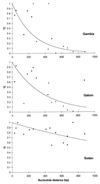High recombination rate in natural populations of Plasmodium falciparum
- PMID: 10200292
- PMCID: PMC16362
- DOI: 10.1073/pnas.96.8.4506
High recombination rate in natural populations of Plasmodium falciparum
Abstract
Malaria parasites are sexually reproducing protozoa, although the extent of effective meiotic recombination in natural populations has been debated. If meiotic recombination occurs frequently, compared with point mutation and mitotic rearrangement, linkage disequilibrium between polymorphic sites is expected to decline with increasing distance along a chromosome. The rate of this decline should be proportional to the effective meiotic recombination rate in the population. Multiple polymorphic sites covering a 5-kb region of chromosome 9 (the msp1 gene) have been typed in 547 isolates from six populations in Africa to test for such a decline and estimate its rate in populations of Plasmodium falciparum. The magnitude of two-site linkage disequilibrium declines markedly with increasing molecular map distance between the sites, reaching nonsignificant levels within a map range of 0.3-1.0 kb in five of the populations and over a larger map distance in the population with lowest malaria endemicity. The rate of decline in linkage disequilibrium over molecular map distance is at least as rapid as that observed in most chromosomal regions of other sexually reproducing eukaryotes, such as humans and Drosophila. These results are consistent with the effective recombination rate expected in natural populations of P. falciparum, predicted on the basis of the underlying molecular rate of meiotic crossover and the coefficient of inbreeding caused by self-fertilization events. This is conclusive evidence to reject any hypothesis of clonality or low rate of meiotic recombination in P. falciparum populations. Moreover, the data have major implications for the design and interpretation of population genetic studies of selection on P. falciparum genes.
Figures



References
-
- Triglia T, Wellems T E, Kemp D J. Parasitol Today. 1992;8:225–229. - PubMed
-
- Walliker D, Quakyi I A, Wellems T E, McCutchan T F, Szarfman A, London W T, Corcoran L M, Burkot T R, Carter R. Science. 1987;236:1661–1666. - PubMed
-
- Wellems T E, Walliker D, Smith C L, do Rosario V E, Maloy W L, Howard R J, Carter R, McCutchan T F. Cell. 1987;49:633–642. - PubMed
-
- Walker-Jonah A, Dolan S A, Gwadz R W, Panton L J, Wellems T E. Mol Biochem Parasitol. 1992;51:313–320. - PubMed
-
- Guinet F, Wellems T E. Mol Biochem Parasitol. 1997;90:343–346. - PubMed
Publication types
MeSH terms
Substances
Grants and funding
LinkOut - more resources
Full Text Sources

